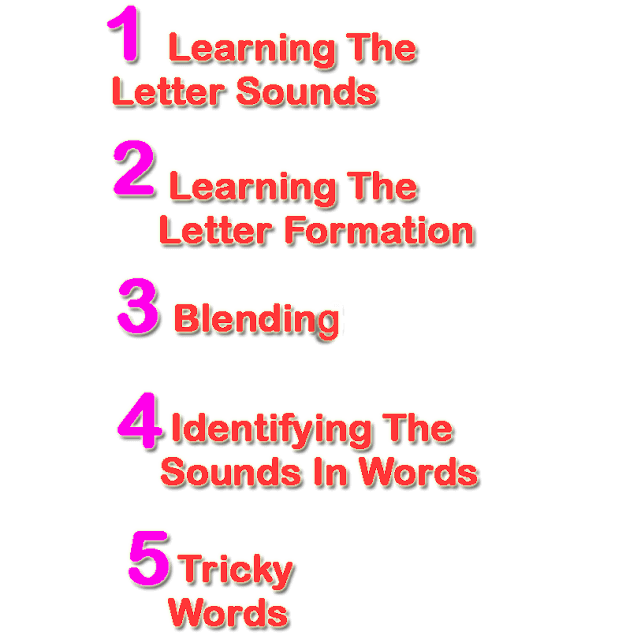
What is Jolly Phonics?
Why Jolly Phonics?
These are 2 of the 5 skills that student need to master jolly phonics:
1-Learning the Letter Sounds
Students are taught Forty Two letter sounds, which is a mix of alphabet sounds (1 sound – 1 letter) and digraphs (1 sound – 2 letters) such as sh, th, ai and ue. Using a multi-sensory approach each letter sound is introduced with fun actions, stories and songs.
students should learn each letter by its sound, not its name. For instance, the letter a should be called a (as in ant) not ai (as in aim). Similarly, the letter n should be nn (as in net), not en. This will help in blending. The names of each letter can follow later.
2-Learning the letter Formation

3-Blending (Jolly Phonics)
 Once the first few letter sounds are learnt, student begin blending the sounds together to help them read and write new words. Students are taught how to blend the sounds together to read and write new words.
Once the first few letter sounds are learnt, student begin blending the sounds together to help them read and write new words. Students are taught how to blend the sounds together to read and write new words.
As well as learning the sounds, the children need to be taught how to blend them together to hear a word. This teaching starts on the first day. The aim is to enable the children to hear the word when the teacher says the sounds, e.g., “Listen carefully, what word am I saying … ‘d-o-g’?” A few students will hear ‘dog’. Try a few more words, e.g., ‘s-u-n’, ‘b-oy’, ‘m-ou-se’.
At first, one way of spelling each vowel sound is taught, e.g., ‘ai’ as in ‘rain’. The student should have practice blending these spellings in words before the alternatives are introduced, e.g., ‘ay’ as in ‘play’ and ‘a-e’ as in ‘lane’.
Once the student have worked their way through the Word Boxes, and learned some irregular common keywords, they should be given storybooks to read for themselves.
Explain to parents that their kid may not bring home a storybook until they have mastered the skill of blending. Parents should then encourage their kid to talk about what they have read.
4-Identifying the sound in Words
When students start reading words, they also need to start identifying the phonic components that make the word sound the way it does. By teaching blending and segmenting at the same time children become familiar with assembling and breaking down the sounds within words.Listening for the sounds in words gives student the best start for improving spelling.

It is essential that student can hear the individual sounds in words, especially for writing. Initially, the student are asked to listen carefully and say if they can hear a given sound in words. Start with words that have three sounds in them, for example, “Is there a ‘s’ in ‘sun’ … ‘mouse’ … ‘dog’?”; “If there is a ‘s’ where does it come – the beginning, middle or end?”. Then the students are encouraged to say the sounds they hear. Practice by saying a word like ‘hat’. The student should respond by saying ‘h-a-t’. As they say each sound they hold up a finger … ‘h-a-t’ three fingers, three sounds; ‘sh-i-p’ three fingers, three sounds, etc. Progress to more complicated words such as those with initial and final consonant blends.
5-Tricky Words
Tricky words have irregular spellings and students learn these separately.After their first month at school, when the majority of the students know about Eighteen letter sounds and have been blending regular letter as a group activity, they can begin to learn the tricky words. Tricky words are words that cannot always be worked out by blending. These can be introduced gradually using the Jolly Phonics Tricky Word Cards. Look at what is ‘tricky’ in each word, e.g., ‘was’ has an /o/ sound in the middle instead of an /a/ sound. Try and teach 2–3 a week, continually revising for reading and spelling.
Three spelling techniques are:
- Look (identify the irregularity and say the word names), Cover, Write and Check.
- Say It As It Sounds, e.g., pronounce ‘mother’ with a short /o/ sound so that it rhymes with ‘bother’
- Mnemonics, e.g., ‘people eat omelettes people like eggs’ to spell the word ‘people’.
